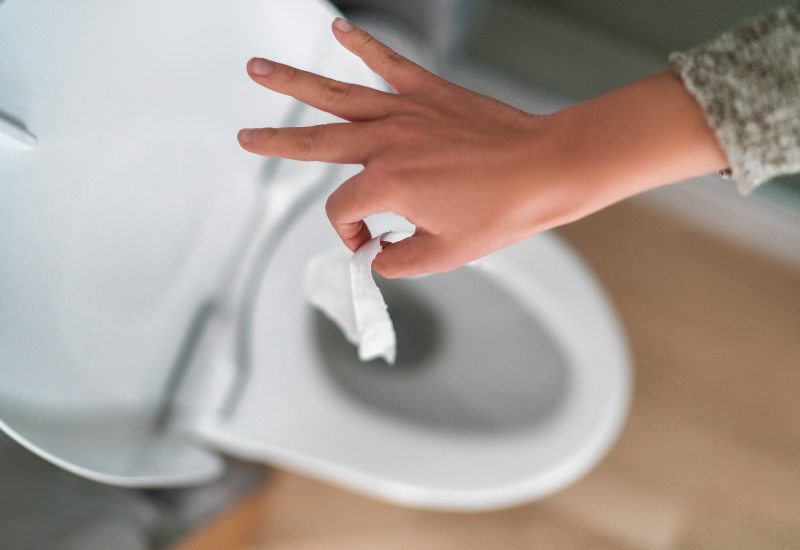
A clogged toilet is enough to make any homeowner’s heart sink. As the water creeps higher and higher in the bowl, you realize your main sewer line may be backed up. Oddly enough, toilet paper, the very product designed to be flushed, often causes this blockage. But don’t fret! You may be able to resolve the issue yourself, and if you can’t, drain cleaning Seattle experts are on standby to help you out.
Understanding Why Toilet Paper Can Cause Clogs
How is it that a flushable product can cause so much trouble with your sewer line? Here are some frequent triggers:
- Excessive use: It’s easy to go overboard and pull off a hefty chunk of paper, but using too much can cause a real sewer line bottleneck.
- Plush over practical: If you use ultra-luxurious toilet paper, you’re setting yourself up for a clog, especially if you have an older plumbing system or septic tank. Thick paper can get trapped in less-than-perfect piping, resulting in a clog.
- Existing obstructions: Do you already have a semi-clogged line? Adding extra toilet paper and waste to the mix is a recipe for a full-fledged blockage.
DIY Fixes for Toilet Paper Clogs
Before calling a professional pipe unclogging service, try these home remedies.
Plunger
The trusty plunger is your first line of defense against toilet paper clogs. First, make sure you select the right plunger for the job. A flange plunger has a smaller inverse cup extending from the bottom of the main cup to offer a better seal around the toilet bowl’s drain hole.
Grip your plunger firmly by the handle and insert the rubber part into the toilet bowl to create a seal. Then, apply strong, quick upward and downward movements. Continue plunging until the water level in the toilet bowl starts dropping, indicating that you’ve cleared the clog.
Dish Soap
Slippery dish soap doesn’t just cut through cooking grease and grime—it can also clear toilet paper clogs. Start by using an old cup or another small container to remove as much water as possible from the toilet bowl. Then, squeeze a generous amount of dish soap into the bowl.
Head into the kitchen and bring a large pot of water to near-boiling. Pour the hot water into the bowl, which works with the soap to break down the paper clog. Let the mixture sit for at least 30 minutes, and then flush the toilet to send the clog on its way down the pipe.
Vinegar and Baking Soda
This dynamic duo can work wonders on a clogged toilet. First, pour a cup of baking soda directly into the toilet bowl. Carefully add two cups of vinegar to initiate a chemical reaction with the baking soda. Wait for 20 to 30 minutes to allow the reaction to break down the clog, and then give the toilet a flush.
Epsom Salt
Epsom salt isn’t just for bath time—it’s also a surprisingly effective method for breaking down toilet paper clogs. To use this method, begin by pouring one to two cups of Epsom salt into the toilet bowl. Add hot water from the tap to help dissolve the salt. Allow things to sit for at least 30 minutes or overnight, if possible. The salt breaks down the toilet paper in the drain, making it easier to flush away.
Clog-Proofing Your Toilet
Now that your toilet is flushing again, you want it to stay that way. Follow these pointers to help prevent recurring issues.
Consider the Low-Flow Toilet Factor
Using less toilet paper is crucial if your bathrooms have low-flow toilets. These eco-friendly fixtures use less water per flush, but this can be problematic if large wads of toilet paper are involved. The rule of thumb is to only use the toilet paper you need and flush more frequently to keep the sewer line clear.
Be Mindful of Thick or Cotton-Based Toilet Paper
Three-ply and cotton-based products may feel luxurious, but they don’t disintegrate as quickly as traditional single-ply paper, leading to more frequent clogs. If you prefer plush toilet paper, be mindful of how much you use and consider more frequent flushing to prevent blockages.
Use a Two-Flush Strategy
If you experience frequent clogs and suspect the mix of solid waste and excessive toilet paper is to blame, consider adopting a two-flush method. This involves flushing before using any toilet paper and then flushing again after. Though this uses twice as much water, it’s far more convenient than placing a service call for toilet repair services.
Watch What Your Flush
The worst sewer line clogs aren’t caused by toilet paper. Other materials like facial tissues, paper towels, feminine hygiene products, and even “flushable” wipes can create stubborn blockages. Set a rule in your household never to flush anything besides toilet paper and human waste.
Schedule Professional Pipe Inspections
One of the best ways to prevent clogs is to learn the condition of your pipes. An annual sewer inspection by a pipe unclogging service can reveal any minor issues before they become significant problems. Regular inspections can identify scaling, minor blockages, and other issues that may cause clogs in the future.
Schedule Toilet Repair Services in Seattle
When DIY solutions won’t cut it, turn to Puget Sound Plumbing and Heating. We are your go-to service for drain cleaning in Seattle, with 24/7 availability when your clogged toilet simply can’t wait. Our skilled and fully licensed technicians are committed to unbeatable results and a positive customer experience. So the next time a clogged toilet threatens to disrupt your routine, call us at (206) 938-3219 to schedule toilet repair services.


